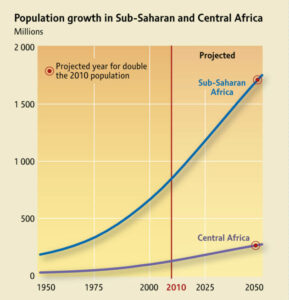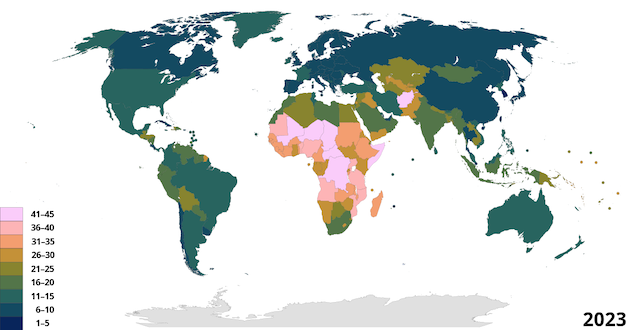Not that long ago, social scientists were worried about “unsustainable” population growth. Now, the reality is that fertility rates are expected to fall below the replacement rate in every region of the world except sub-Saharan Africa by 2040.
A comprehensive demographic analysis for the Global Burden of Disease Study analyzed global fertility in more 200 countries between 1950 and 2021 and provides forecasts on future fertility rates to 2100.
“Fertility rates have declined dramatically around the world since 1950 and will continue to decline in almost all countries and territories up to 2100,” the report said. “While human civilization is converging on a sustained low-fertility reality, comparatively high fertility rates in some low-income countries and territories will result in a clear demographic divide between a subset of low-income countries and the rest of the world.”
According to statista.com, the world’s most populous countries are India at 1.435 billion people, having surpassed China at 1.425 billion. Next is the United States at 340 million with 7 million having of those entered through the southern border since January 2021.
The U.N. says earth’s population has risen from about 1 billion In 1800 to 2.3 billion in 1940, then 3.7 billion in 1970, and approximately 8 billion in 2022. You’d think that would be enough to sustain civilization.
The global fertility rate has dropped from 4.83 in 1950 to 2.23 in 2021. The total fertility rate is measured as the number of children born per woman. The report defines the replacement-level fertility rate, referring to the “minimum rate necessary for generational replacement of the population,” as 2.1.

The report elaborates on the consequences of declining total fertility rates worldwide, predicting that “sustained low fertility rates — and a resulting contraction and aging of the population — will lead to serious economic challenges and increasing pressure on health systems, social security programs and the labor force.”
In the U.S., according to VOX, the US, the birth rate has “been falling since the Great Recession of 2008, dropping almost 23 percent between 2007 and 2022. Today, the average American woman has about 1.6 children, down from three in 1950, and significantly below the “replacement rate” of 2.1 children needed to sustain a stable population.”
In Italy, Vox reports, “12 people now die for every seven babies born. In South Korea, the birth rate is down to 0.81 children per woman. In China, after decades of a strictly enforced one-child policy, the population is shrinking for the first time since the 1960s. In Taiwan, the birth rate stands at 0.87.”
Comparatively high fertility rates in poorer regions of the world will lead to “serious challenges related to sustaining and supporting a growing young population in some of the most heat stressed, politically unstable, economically vulnerable, health system-strained locations,” researchers said. Implementing policy changes in the immediate future, especially in countries where the total fertility rate is at 1.75 or lower, may help prevent the total fertility rate from falling to the projections outlined in the “reference scenario,” the report said.
Today, countries are now paying their citizens to have more children. Russia, one of the countries hit hardest by a decreasing fertility rate, women can receive a one-time lump sum of $7,000 for families over two children. In Hungary, introduced loans of $30,000 to newlyweds. Greece and Italy have bonuses per child.
It’s not known if it is really having an effect.
“Even the richest, savviest, most committed governments have struggled to find policies that produce sustained bumps in fertility,” Trent MacNamara, a history professor at Texas A&M who has written about fertility rates. “If such policies were discoverable, I think someone would have discovered them,” he told Vox.
–Dwight Widaman | Metro Voice








